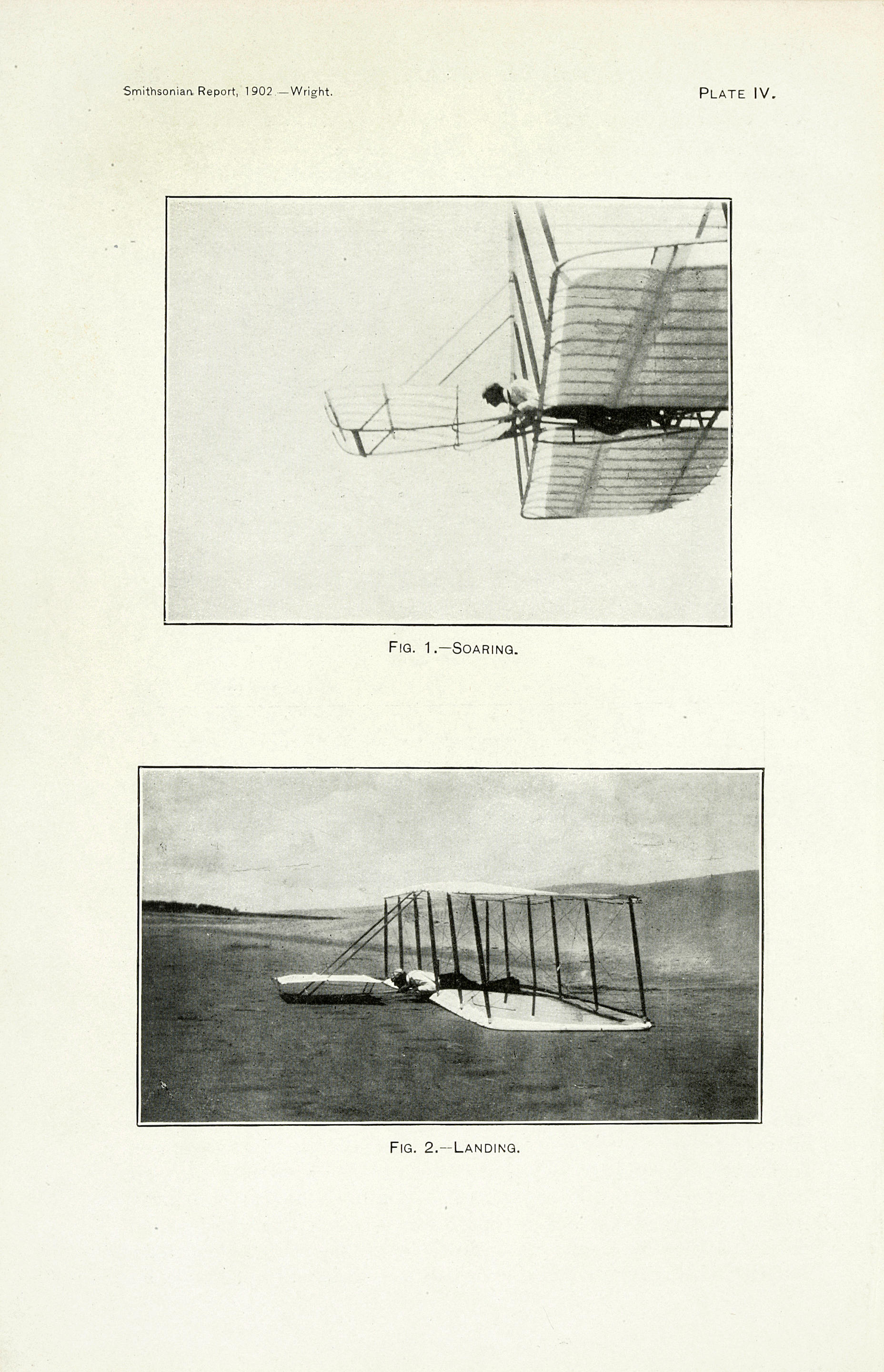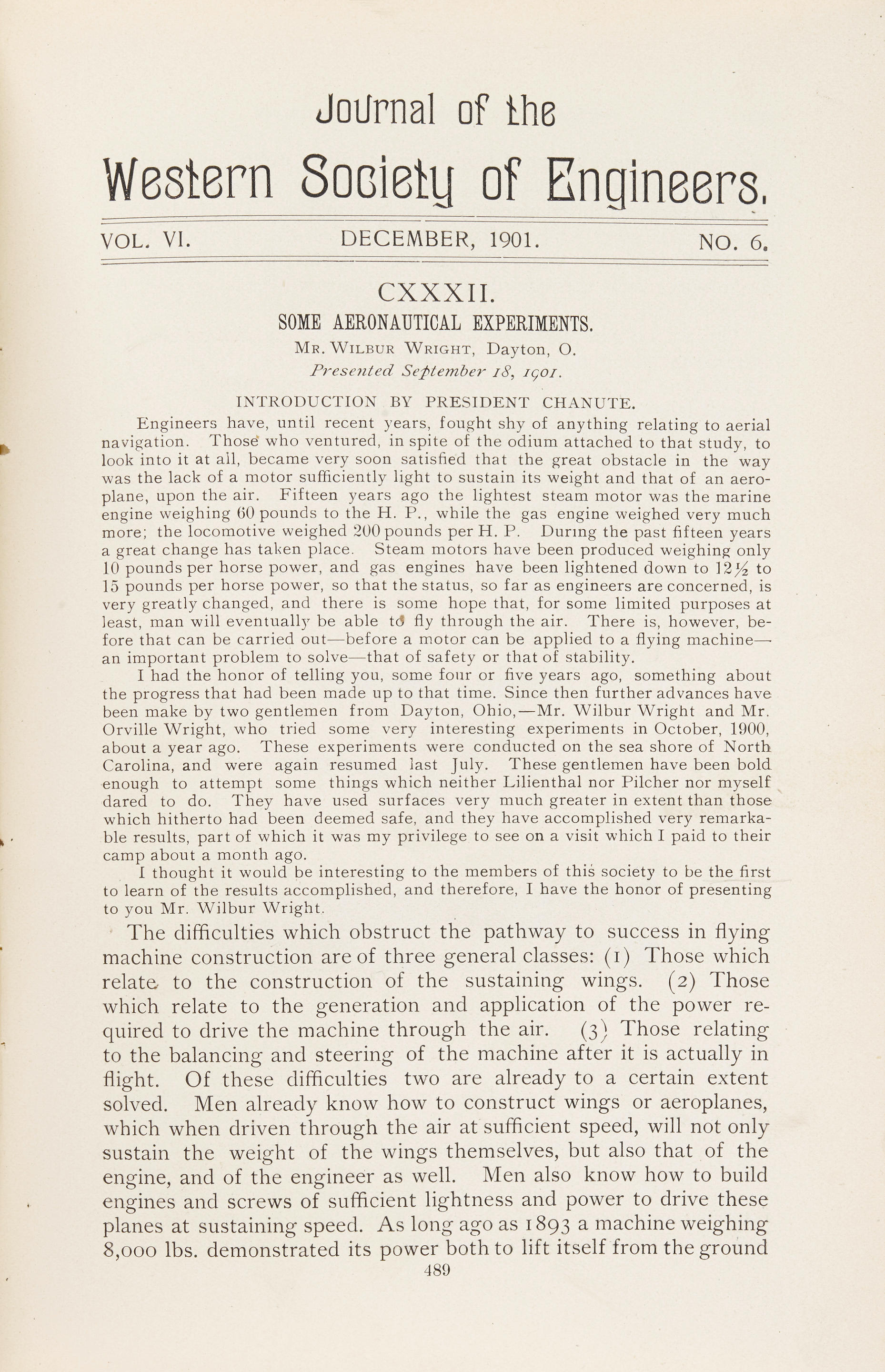WRIGHT, Wilbur (1867-1912). “Some Aeronautical Experiments.” Offprint from: Journal of the Western Society of Engineers Vol. 6 (December, 1901). [Chicago, 1901].
WRIGHT, Wilbur (1867-1912). “Some Aeronautical Experiments.” Offprint from: Journal of the Western Society of Engineers Vol. 6 (December, 1901). [Chicago, 1901]. First edition, offprint issue, of the Wright brothers' first published report of their trial flights with motorless gliders at Kitty Hawk. This important paper was written and read to the Society at the urging of its president Octave Chanute, a French-born civil engineer whose passion for aeronautics made him "an international clearing house for information on aviation" ( The Wright Brothers: Heirs of Prometheus , Smithsonian Institution 1978, p. 15), and whose own carefully tabulated gliding experiments in 1896 and 1897 paved the way for the Wrights' later successes. "Chanute was so certain of this paper's significance that he ordered 300 copies of the offprint, 150 of which he sent to colleagues in the United States and abroad, and 150 of which he sent to the Wright brothers for their own use" (Norman). Rare. 8vo (230 x 153 mm). 10 halftones reproducing photographs and 2-line block illustrations in text. Original printed wrappers; cloth folding case. Dibner Heralds of Science 185; Norman 2266. The 1896 death of Otto Lilienthal in a glider crash reawakened Orville and Wilbur Wright's interest in aeronautics, and, after three years intensely studying the existing aeronautical literature, the brothers built their first flying machine, a biplane kite-glider with a 5-foot wingspread. Their glider was modeled upon Octave Chanute's five-plane glider, but incorporated wing-warps--Wilbur Wright's solution to the problem of lateral control. A year later they built their first full-sized glider with a 17 foot span, and in the summer of 1900, a still larger glider with a 22-foot wing-span. The present paper, which Wilbur read to the Western Society of Engineers on September 18, 1901, describes these progressive developments and the brothers' trial flights at the beach of Kitty Hawk, North Carolina in the summer of 1901, during which they achieved glides of up to 389 feet. "Their work was painstaking, thoroughly scientific, with a careful tabulation of data and critical examination of all conclusions. The glides indicated that a vertical steering rudder was essential... and that calculations based on existing data were in error" ( DAB ). In order to perfect their machine's performance, the Wrights returned to Dayton to pursue their aerodynamic research.
WRIGHT, Wilbur (1867-1912). “Some Aeronautical Experiments.” Offprint from: Journal of the Western Society of Engineers Vol. 6 (December, 1901). [Chicago, 1901].
WRIGHT, Wilbur (1867-1912). “Some Aeronautical Experiments.” Offprint from: Journal of the Western Society of Engineers Vol. 6 (December, 1901). [Chicago, 1901]. First edition, offprint issue, of the Wright brothers' first published report of their trial flights with motorless gliders at Kitty Hawk. This important paper was written and read to the Society at the urging of its president Octave Chanute, a French-born civil engineer whose passion for aeronautics made him "an international clearing house for information on aviation" ( The Wright Brothers: Heirs of Prometheus , Smithsonian Institution 1978, p. 15), and whose own carefully tabulated gliding experiments in 1896 and 1897 paved the way for the Wrights' later successes. "Chanute was so certain of this paper's significance that he ordered 300 copies of the offprint, 150 of which he sent to colleagues in the United States and abroad, and 150 of which he sent to the Wright brothers for their own use" (Norman). Rare. 8vo (230 x 153 mm). 10 halftones reproducing photographs and 2-line block illustrations in text. Original printed wrappers; cloth folding case. Dibner Heralds of Science 185; Norman 2266. The 1896 death of Otto Lilienthal in a glider crash reawakened Orville and Wilbur Wright's interest in aeronautics, and, after three years intensely studying the existing aeronautical literature, the brothers built their first flying machine, a biplane kite-glider with a 5-foot wingspread. Their glider was modeled upon Octave Chanute's five-plane glider, but incorporated wing-warps--Wilbur Wright's solution to the problem of lateral control. A year later they built their first full-sized glider with a 17 foot span, and in the summer of 1900, a still larger glider with a 22-foot wing-span. The present paper, which Wilbur read to the Western Society of Engineers on September 18, 1901, describes these progressive developments and the brothers' trial flights at the beach of Kitty Hawk, North Carolina in the summer of 1901, during which they achieved glides of up to 389 feet. "Their work was painstaking, thoroughly scientific, with a careful tabulation of data and critical examination of all conclusions. The glides indicated that a vertical steering rudder was essential... and that calculations based on existing data were in error" ( DAB ). In order to perfect their machine's performance, the Wrights returned to Dayton to pursue their aerodynamic research.











.jpg?height=400)



Try LotSearch and its premium features for 7 days - without any costs!
Be notified automatically about new items in upcoming auctions.
Create an alert